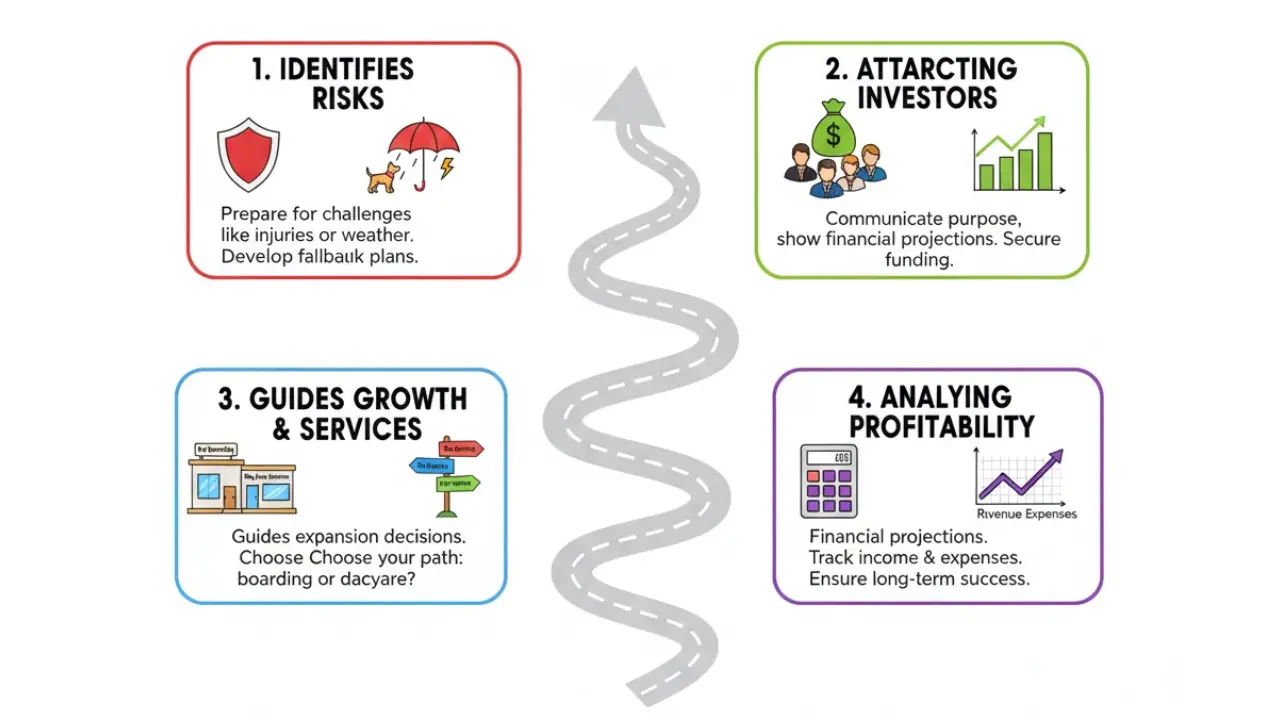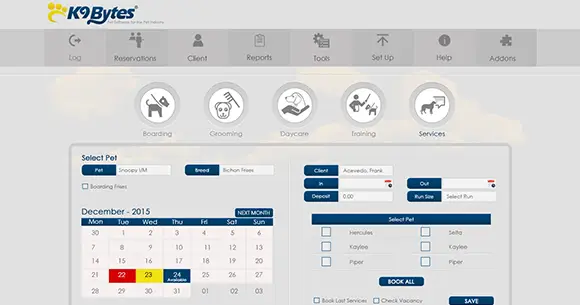Crafting a solid business plan for a dog kennel is important for turning passion into profit in the booming pet care industry. This guide outlines the critical steps from an executive summary and detailed company overview to a thorough market analysis and robust financial projections. Learn how to identify risks, attract investors, and strategize for growth by meticulously planning services, operations, and marketing. With pro tips for research and readability, this summary equips aspiring entrepreneurs to build a professional, successful, and future-ready dog kennel business.

Running a business can be a wonderful thing if you are surrounded by something you love, and many dog lovers dream of starting their own kennel business. As households become more open to owning pets, the demand for kennels and pet boarding services, especially in the U.S., is slowly increasing.
The U.S. kennel services are expected to grow at a Compound Annual Growth Rate (CAGR) of approximately 8.59% from 2025 to 2030, with around 139,000 pet grooming and boarding services operating in the United States. Given this, every pet lover is now scrambling to start and create their own dog kennel business plan, from determining the services to offer to deciding where to set it up.
In this blog, we will walk you through how to write a successful dog kennel business plan step-by-step.
Why a Business Plan Matters for Your Dog Kennel?

Being passionate and enthusiastic are the primary drivers in building a dog kennel service that provides excellent care to both pets and their owners. But it goes without saying that any business without a plan is bound to fail. When it comes to providing pets and owners with the best services, you need a clear structure and design. Creating a plan before starting a dog kennel business is considered the backbone of your business’s success. It is a clear roadmap of how your business will prosper in the years to come.
Here are some key points to consider regarding the importance of creating a pet business plan.
1. Identifies Risks and Benefits Beforehand
A dog kennel business plan prepares you to face any potential risks and challenges your pet daycare might face. Business plans serve as a framework to guide you in developing fallbacks in cases of unforeseen circumstances, such as unexpected dog injuries or extreme weather events.
2. Attracting Investors
A pet business plan allows you to communicate the purpose of your business and, in turn, attract investors who can secure funding for your pet daycare. Having a financial projection and a clear business model can help you assess your business funding needs.
3. Analyzing Growth Trajectory
A clear path for your pet kennel business guides you to make big decisions when it comes to expanding your business. Pet kennel businesses provide different services, and with the help of a business plan, you get to decide if the business is going with a pet boarding or a Dog Daycare Business route. Having a solid pet business plan provides you with answers about the future of your business.
Step-by-Step Guide: How to Write a Successful Dog Kennel Business Plan

A cohesive and comprehensive plan is considered the most important step when venturing into a business. When starting your dog kennel business plan, here are the steps to consider:
1. Executive Summary
An executive summary is the introduction to the heart of your cause, or in this case, your business. It should include your mission, vision, and goals, as well as the reasons behind creating a pet kennel business.
This section of your business plan should outline who you are, including the type of dog kennel business you operate, your direct competitors, and a brief overview of your financial and marketing strategies.
2. Company Overview
While the executive summary provides a glimpse into the overall foundation of your business and its goals, this part of your kennel startup strategy is where you can lay everything out in detail.
If you operate an overnight boarding dog kennel, specify the services you offer, such as overnight pet stays, along with food and other amenities for dogs. If it is a day care, identify the operating hours and the nature of the socialization activities.
3. Market Analysis
The market analysis part of your business plan should answer how big your dog kennel business would be, what pet breeds you are targeting to accommodate, and who your area’s biggest competitors are.
This section of your business plan demonstrates to the reader that you understand the fundamentals of the dog kennel industry. You are identifying the key trends and tricks that keep the industry marketable and running.
4. Services and Pricing
You can set yourself apart through the services and pricing you offer. Revolve them around the needs of the pet industry in your area and match the prices your competitors offer.
If most pet owners in your area require dog daycare, prioritize that service along with pet grooming and other engaging activities to ensure their pets are entertained while they save money.
5. Operations Plan
These are everyday processes and long-term methods you will use to keep the business running. It integrates everything stated in the previous parts of your plan, making a complete layout of the kennel.
This section of the pet business plan outlines daily tasks within the business, including cleaning crates, feeding the animals, and supervising playtime, along with the key individuals assigned to perform these duties.
6. Marketing Strategy
When conducting market analysis for dog kennels, clearly define the type of kennel you are offering and the specific services you provide. For example, in addition to doggy daycare services, you also provide pet training and grooming.
Cute dog grooming clips and other amusing pet videos are what’s trending on social media. This could be a great marketing strategy to promote your business and provide a compelling introduction to what your company has to offer.
7. Financial Plan
Financial projections for kennel businesses significantly impact the economic prospects of your business. If your kennel assumes to board at least 20 pets at a time, how much will your sales grow?
The typical financial plan is set for a five-year course, broken down into income statements, balance sheets, and cash flow statements. And with the help of studying the market, you are rooting financial assumptions in reality.
8. Risk and Growth Plan
A risk and growth plan in the Kennel industry outlines how your business will identify and overcome potential threats, as well as different strategies for expansion. When combined, they create a comprehensive plan for business growth.
A risk and growth plan includes potential risks, such as market oversaturation and internal issues, as well as detailed plans for mitigation, including extra business savings and team member training.
Pro Tips to Make Your Plan Stand Out

A business plan helps convince potential business partners and investors of the potential of your business. Your dog kennel business plan should convey a professional and effective image.
1. Research Is Key
Choosing the right niche for your pet business is the ultimate key to success. You can uncover the untapped pet needs of your community and incorporate them into your business plan as a potential business opportunity.
2. Make It Easy To Read
Readers who lack business insights often misunderstand business jargon. Keeping your dog kennel business plan’s language accessible to every reader, regardless of their level, makes it unique.
3. Update Your Plan Yearly
As your business grows, the elements that comprise your business plan also evolve. It is best to update your goals and business plan components annually to identify what changes and what remains the same.
Writing a dog kennel business plan doesn’t have to be the longest book in the world. When writing a business plan for a dog kennel, remember to convey the heart of your business to attract potential partners in the process.
Take the Next Step!
Like you, many pet lovers are gearing up to start their dog kennel business, and some might have taken the leap of faith. However, having confidence that you will do well will depend on how well-prepared you are. When an aspiring business owner fails to research their market and develop a business plan, it is all for nothing. Every great business begins with a plan, and your dream kennel is just one business plan away.
FAQs About Pet Kennel Business Plan
Q: What legal permits are needed for a dog kennel?
A: Typically, you will need a business license, zoning permits, and animal care facility licenses. Check local city/county laws.
Q: How much startup capital is needed for a kennel?
A: Varies greatly by scale, from tens of thousands for small daycares to hundreds of thousands for larger boarding facilities. Budget for property, equipment, licensing, staff, and initial operations.
Q: What essential insurance does a dog kennel require?
A: General liability, professional liability, property insurance, and workers’ compensation are crucial. Consider pet-specific injury/illness policies.
Q: How do I research my local market and competitors?
A: Visit local kennels, read reviews, survey pet owners, analyze local demographics, and study area pet ownership statistics to find gaps and competition.
Q: What are common business plan mistakes for new kennels?
A: Underestimating costs, poor market research, lacking a unique strategy, infrequent updates, and not planning for staff turnover or emergencies.



